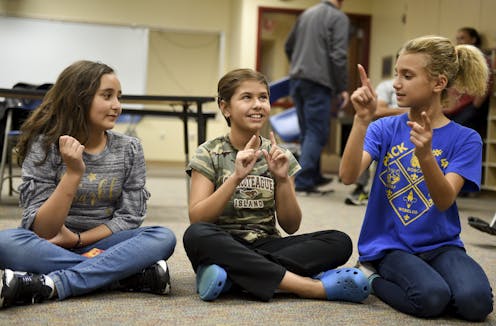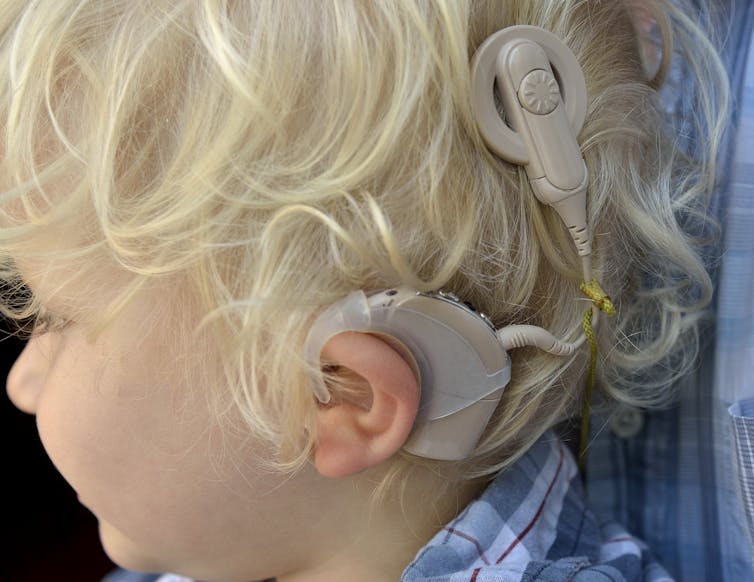Parents of deaf children often miss out on key support from the Deaf community
Families with deaf children often seek a lot of advice and help, but too rarely find the robust Deaf community in the US full of people with experience and expertise.

An increasing number of deaf and hard-of-hearing kids in the U.S. are receiving cochlear implants – electrical conductors surgically inserted into the inner ear to stimulate the nerve responsible for hearing.
Fewer than 30,000 U.S. children had received cochlear implants by 2010, while an estimated 65,000 children had them by 2019. This is due to continuously improving medical and technological advances in cochlear implantation that make it cheaper and less painful to hear better than they would with other types of devices.
Yet most kids with cochlear implants still need significant help learning to understand and produce spoken language, much less learn material taught in lessons primarily meant for students who can hear. And they often struggle to fit in with peers who were born hearing, sometimes only finding a community that truly understands their life’s journeys upon reaching adulthood and connecting with other people who were born deaf or hard of hearing.
When parents choose to get their child a cochlear implant, they are no doubt making the best choices they can with the information and understanding they have about growing up and living in a world where most people can hear.
But too often they miss out on key support for themselves, and for their kids, from the Deaf community, which I am a part of – as the deaf mother of a deaf son – and which I study professionally. People who are deaf or hard-of-hearing, and those with average hearing all use sign language – the most common of which in the U.S. is American Sign Language – to fully understand and express themselves in ways that go beyond speech, and help each other navigate the challenges presented in a hearing world.

Key materials leave out vital information
According to the U.S. Food and Drug Administration, some of the benefits of having a cochlear implant include being able to understand speech without lip reading, making telephone calls, watching TV and enjoying music.
Many professional websites maintained by hearing implant specialists boast that deaf and hard-of-hearing children can be successfully trained to speak and hear for full integration in their communities.
But these sources leave out key information, such as the common need for assistance in school even after getting a cochlear implant. Their primary focus, as with many consultations with hearing specialists, audiologists and speech therapists, is on helping deaf and hard-of-hearing children learn to listen and speak.
These efforts downplay or ignore the idea that there are other ways deaf and hard-of-hearing people can communicate, without hardship or difficulty. For instance, on the U.S. Centers for Disease Control and Prevention website section about screening for congenital deafness, the emphasis is on providing deaf and hard-of-hearing children early intervention services to avoid delays in learning to speak. Information on American Sign Language is reached only by clicking to another page and reading through a bullet list of technical jargon like “auditory-oral” and “cued speech.”
A history of oppression
Over decades, even centuries, the Deaf community in the U.S. and around the world has been ignored, and even repressed, by mainstream hearing society.
As far back as the 19th century, educators of deaf people, such as telephone inventor Alexander Graham Bell, have tended to believe that speaking and listening are critical to functioning in the broader society. As a result, they have discouraged children from learning to sign, even though research shows that if kids can communicate effectively without speaking, they’ll be more interested in learning speech.
This resulted in the methods used to teach generations of deaf Americans, including me, at schools for the deaf. I was not allowed to use American Sign Language in the classroom, but rather what was called the “Rochester Method,” a combination of speech and fingerspelling.
Attendance at these schools, which are mostly residential, has been declining since the 1975 passage of the first federal law requiring public school systems to offer a range of education options for students with different medical or physical conditions, including hearing loss. One option was placement in mainstream schools with aides for assistance.
But public schools aren’t always good at supporting deaf and hard-of-hearing students, who often struggle to follow along and fit in at school, including classrooms, hallways, cafeterias and recreational spaces – all of which can be very noisy, making it hard to distinguish one person’s voice from another.
Little attention paid
All this history helps explain why there is so little research about the Deaf community, and why officials and families often don’t know much about it.
There is no recent census data or systematic research on the use of American Sign Language. The best figure I’ve ever found was published in 2004, when the University of Iowa’s Department of Speech Pathology and Audiology estimated that between 250,000 and 500,000 people in the U.S. – both deaf and hearing – used American Sign Language.
In my personal and professional experience, this group – the Deaf community – is made up of people who are well equipped to support the mental, emotional and social health of deaf and hard-of-hearing children and their families. They participate fully in society, holding a wide range of jobs unhindered by the limits on their hearing. And they have come to understand the role of deafness in their own identities and lives. The HeART of Deaf Culture website offers a selection of creative works that present profound insight for Deaf identity affirmation.
Yet deaf children who are taught to speak often struggle with language delays through childhood and into adulthood. Teaching them to sign, however, can help them fully express their thoughts, feelings and ideas, and find acceptance and connection with others with similar experiences. I believe these children deserve to be taught to sign, to celebrate their deaf identity.
And many parents of deaf children want more help from the Deaf community than they are able to find. A 2018 survey found that just 27% of hearing families with a deaf child were connected with deaf adults to help support their child.
One parent told the surveyors: “I wish we could have a deaf mentor or at least access to a program. I really would like to have a deaf person weekly in our home teaching us.” And 8% of parents of deaf children reported wanting access to instruction in American Sign Language.
But there are not enough sign-fluent professionals available to meet that need.
As parents make their decisions about how best to support their deaf and hard-of-hearing children, they will definitely encounter a large number of medical experts, speech therapists and other professionals who want to help their kids function in a world that places a lot of emphasis on hearing. But they should know there is another community available, too, standing ready to help their deaf and hard-of-hearing kids, with or without cochlear implants, gain deeper understanding of themselves and more fully develop their limitless human potential.
Pamela Renee Conley does not work for, consult, own shares in or receive funding from any company or organisation that would benefit from this article, and has disclosed no relevant affiliations beyond their academic appointment.
Read These Next
From truce in the trenches to cocktails at the consulate: How Christmas diplomacy seeks to exploit s
World leaders like to talk up peace at Christmastime. But alongside the tales of seasonal breaks in…
As DOJ begins to release Epstein files, his many victims deserve more attention than the powerful me
Powerful men connected to Jeffrey Epstein are named, dissected and speculated about. The survivors,…
How to reduce gift-giving stress with your kids – a child psychologist’s tips for making magic and a
Depending on family circumstances and a child’s personality type, gift giving runs the gamut of fun…






